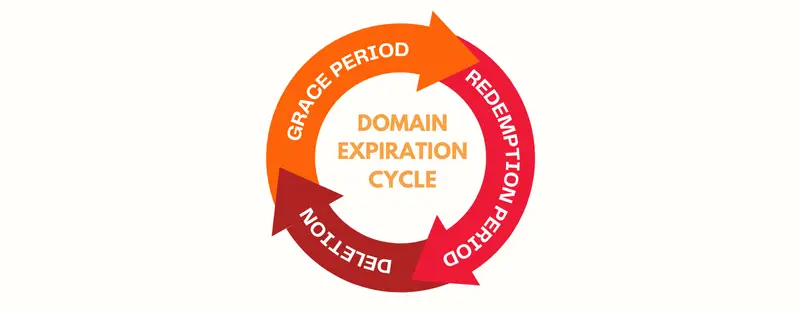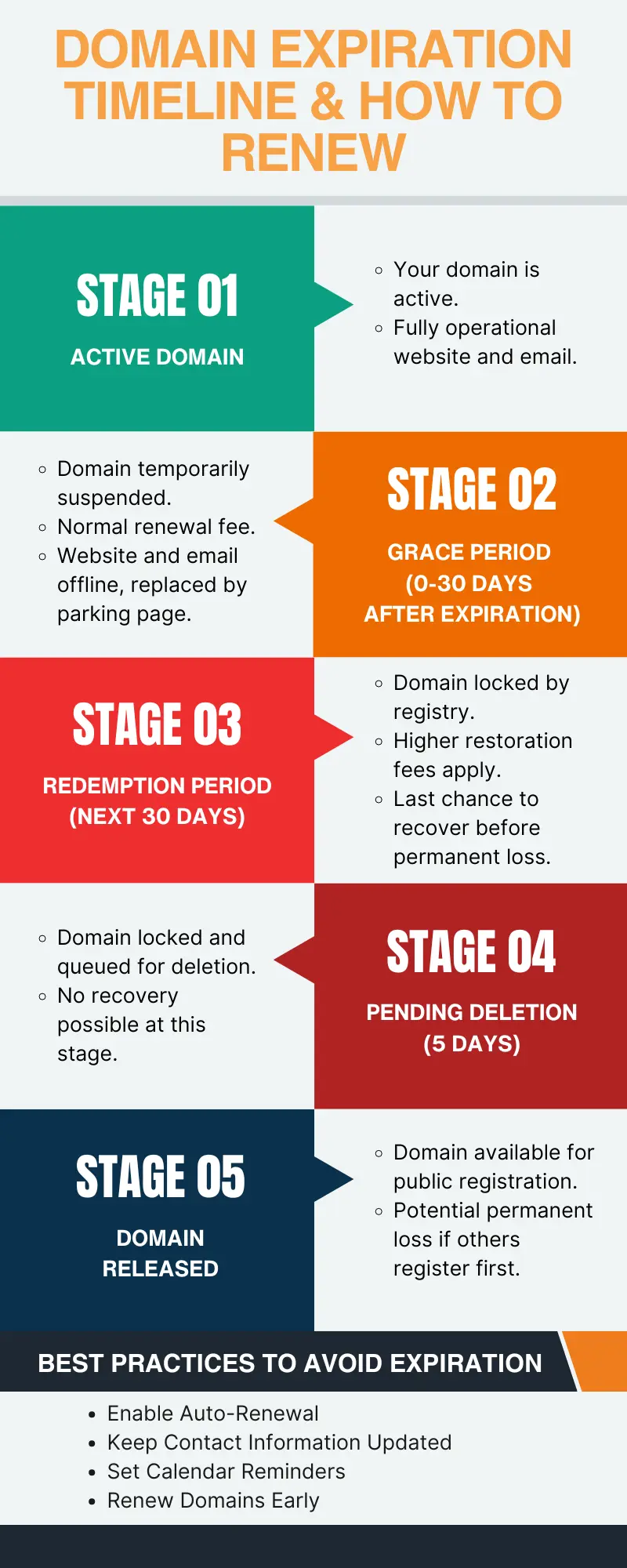With generic TLDs being oversaturated and marketed globally, country domains can help you reach a local audience and boost SEO.
Domain Expiration and Renewal Guide: What Happens & How to Renew
Written by Steven White ·

Introduction
Domain names are the digital addresses of businesses, organizations, and individuals online. Owning a domain name gives you a unique identity on the internet, allowing users to find your website and send emails to your domain. However, domain ownership isn’t permanent – each domain registration lasts for a fixed period and must be renewed to remain active. If a domain is not renewed by its expiration date, it will eventually expire. Understanding what happens when a domain expires is crucial for every domain owner. An expired domain can lead to website downtime, lost emails, and even the permanent loss of the domain name to someone else. This article will explain the entire domain expiration cycle and provide guidance on renewing your domain in time to avoid losing it. You will learn why domains expire, what happens during each phase (grace period, redemption, deletion), the consequences of letting a domain lapse, and how to recover an expired domain. By understanding these phases and following best practices, you can keep your valuable domain names under your control.
Table of Contents
- Understanding Domain Expiration
- The Domain Expiration Cycle
- Consequences of Domain Expiration
- How to Renew an Expired Domain
- Best Practices for Domain Renewal
- Final Thoughts
- References
Understanding Domain Expiration
What is domain expiration? Domain expiration refers to the process by which a registered domain name reaches the end of its registration term without being renewed. When you register a domain, you essentially lease the right to use that name for a specified period (commonly one year, though multi-year registrations are possible). Each domain has an expiration date. If you do not renew the domain before or by that date, the domain will expire, meaning you will no longer have an active registration for it.
It’s important to realize that you never “own” a domain name outright; you only have exclusive rights to it as long as you keep renewing the registration. Once the expiry date passes without renewal, your control over the domain begins to lapse. The domain doesn’t immediately become available to others the second it expires – there is an expiration process (detailed in the next section) – but from the moment of expiration, you are at risk of losing the domain if no action is taken.
Common reasons why domains expire: Domains often expire simply because the registrant (owner) forgets to renew them. Here are some of the most common reasons a domain might unintentionally expire:
- Failure to track the renewal date: The owner did not remember the expiration date or lost track of time, so the deadline passed unnoticed.
- Outdated contact information: The email address on file for the domain registration was old or not monitored, so renewal reminder notices from the registrar went unseen. If the owner doesn’t receive or read the reminders, they might miss the chance to renew on time.
- Auto-renewal issues: Many registrars offer automatic renewal, but auto-renew can fail if the payment method is expired or invalid (for example, an old credit card on file). If the payment fails and the owner isn’t aware, the domain can expire despite the auto-renew setting.
- Administrative oversight: For businesses or organizations, the person responsible for renewals might leave the company or change roles, and the task falls through the cracks. The domain could expire simply due to internal miscommunication or oversight.
Regardless of the reason, the result of a domain expiring is the same: the domain registration is no longer active. Once expired, the domain will eventually stop functioning – meaning any website or email services tied to it will cease working. The situation can be remedied if caught in time, but it’s far better to prevent a domain from expiring in the first place. Next, we’ll explore what happens after a domain expires and how you can still renew or restore it at each stage of the process.
The Domain Expiration Cycle
When a domain expires, it does not immediately become available for someone else to register. Instead, it goes through a defined expiration cycle with multiple phases. This cycle is in place (especially for generic top-level domains like .com, .org, .net, etc.) to give the original registrant multiple chances to recover the domain before it is finally released to the public. The exact timing can vary slightly depending on the domain extension (TLD) and the registrar’s policies, generally including a grace period, a redemption period, and finally a pending deletion phase before the name is dropped.

Below, we explain each of these phases in detail and what actions (if any) you can take during each one. It’s important to note that during the expiration cycle, the domain will typically be taken offline – your website will not be reachable and email services will fail. Registrars often replace your DNS with a parking page or a notice during this time. Let’s look at the phases step by step:
Grace Period (Renewal Grace Period)
The first phase after a domain’s listed expiration date is usually the Grace Period. This is also called the renewal grace period or auto-renew grace period. In many cases it lasts around 30 days (though it can range from a few days up to 45 days, depending on the top-level domain and registrar). During the grace period, the original registrant still has the opportunity to renew the expired domain at the normal renewal cost, without any additional penalty fee.
Here’s what typically happens in the grace period:
- The day after expiration, the registrar typically suspends the domain. The name servers are often changed to point the domain to a generic parking page or an expiration notice, so your website is replaced by a placeholder (and may show a notice or ads) and any email service on the domain stops functioning. This serves as a clear signal that the domain has expired and action is needed.
- During the grace period, you (the original owner) can log into your registrar account and renew the domain as if it were still active. The cost will typically be the standard renewal fee (e.g., another year of registration at the usual price). There is generally no extra late fee required during this phase. Once renewed, the domain is reactivated, and your website/email should resume normal operation (though there might be a short DNS propagation delay before everything is fully back to normal).
- If you renew during the grace period, the expiration date is extended (for example, if your domain expired on May 1 and you renew on May 15 during grace, the new expiration might be May 1 of the next year). It will be as if the domain never lapsed, and you retain uninterrupted ownership.
Remember, the grace period length isn’t the same for every domain. Many standard domains (like .com, .net, .org) have about a 30-day grace period (some registrars may extend up to 45 days), whereas some extensions (especially certain country-code domains) may have a shorter or even no grace period. You should verify the policies for your specific TLD with your registrar. If the domain is not renewed by the end of the grace period, it will typically move into the next stage of the cycle – the Redemption Period.
Redemption Period
After the grace period lapses without renewal, most expired domains enter what is known as the Redemption Period (sometimes called the Redemption Grace Period, or RGP). The redemption period typically lasts about 30 days. This is essentially a last-chance window for the original registrant to reclaim the domain before it’s dropped from the registry.
In the redemption phase, the domain is no longer simply on hold – it’s been flagged for deletion at the registry level. Technically, the registrar informs the registry to delete the domain, and the registry marks the domain as in redemption (often the status code in WHOIS will show something like “redemptionPeriod”). The domain at this point is not resolving (no website or email will function) and it is not available for others to register yet. It’s in a kind of limbo state, reserved for the possibility of restoration by the previous owner.
Key characteristics of the redemption period include:
- Cost and procedure: To recover a domain in redemption, you must pay a redemption or restoration fee in addition to the normal renewal fee. This fee is often substantial (on the order of $80-$150 or more) and is required because the registrar must manually restore the domain from the registry’s redemption hold.
- Limited 30-day window: The redemption period lasts about 30 days, during which the domain is in limbo. It will not work (no website/email) and cannot be registered by anyone else during this time. Only the previous registrant (through the registrar) can reclaim it. If you do not request restoration within this window, the domain will move on to the next stage (pending deletion) and you effectively lose your exclusive right to recover it.
- Restoration outcome: Upon paying the required fees and requesting a restore, the registrar will restore the domain. The domain’s registry status returns to normal (this may take a day or two), your ownership is reinstated, and the domain’s expiration date is extended (typically by one year, because a renewal is usually included in the process).
The redemption period is a safety net mandated for most generic domains to protect registrants from losing domains due to forgetfulness or other issues. It provides a final opportunity to get the name back, but at a higher cost. Not all domain types have a redemption period – many country-code TLDs have their own rules (some have no redemption phase or different timelines). If your domain is in redemption, it’s critical to act quickly. Once the 30-day redemption window passes without renewal, the domain will proceed to the next phase, pending deletion.
Pending Deletion
The Pending Deletion phase is the last stage of the expiration cycle. This stage usually lasts about 5 days for most gTLDs. Once a domain reaches pending delete status, it means the redemption period ended with no action – the domain is now slated for removal from the registry. At this point, the original owner no longer has any ability to recover the domain through the registrar; the window to redeem has officially closed.
During pending deletion:
- The domain is locked in a pending delete status at the registry. No changes can be made – you cannot renew, redeem, or modify the domain in any way. The registrar also cannot intervene to stop the deletion at this point.
- This period is essentially a waiting period mandated by the registry before final deletion. From a user perspective, the domain remains offline and nonfunctional, just as it was during redemption.
- No one else can register the domain during the pending delete phase. However, this is when many interested third parties (such as domain investors or others who want the name) are getting ready to try and register it the moment it drops.
After five calendar days in pending delete, the domain is deleted from the registry database. The exact drop time depends on the registry’s schedule, but it’s typically at a fixed time of day when batches of expired domains are released. Once dropped, the domain becomes available for anyone to register on a first-come, first-served basis. In practice, valuable domains are often snapped up immediately by automated “drop catching” services as soon as they are released.
For the original owner, if your domain reaches this stage and is deleted, the only way to get it back is to attempt to register it again as a new domain. You have essentially lost the domain, and there is no priority given to the previous owner. You can try to re-register it manually the instant it becomes available, but competition is usually intense. Many companies offer backorder services to catch dropping domains on behalf of customers. If someone else successfully registers the domain before you, they become the new owner, and you would have no recourse aside from attempting to purchase it from them or pursuing legal action if applicable. This outcome underscores why it’s critical to renew domains before they ever reach the pending delete stage.
Consequences of Domain Expiration
Allowing a domain name to expire can have serious consequences. The severity of the impact depends on how important the domain is to you or your business and how quickly you act to resolve the expiration. Here are some of the main risks and outcomes when a domain expires:
- Website and Email Outage: As soon as a domain expires (and certainly once it enters the grace period on hold), any website associated with that domain will go down. Visitors will either see an error or a parking page instead of your site. Similarly, any email addresses using that domain (for example,
[email protected]) will stop working, causing emails to bounce. This can disrupt communications and business operations. If you run an e-commerce site or a critical service, even a short downtime due to an expired domain can mean lost revenue and frustrated customers. - Loss of Domain (and Potential Costly Recovery): If the domain progresses through all expiration stages and is released, someone else can register it and take ownership. At that point, you no longer have any rights to the name. Recovering it may require purchasing it from the new owner, often at a very high price (if the new owner is even willing to sell), or you might not be able to get it back at all.
- Security and Brand Reputation Risks: If your domain falls into someone else’s hands, they might put up content that misleads your customers or tarnishes your name. Visitors who still associate that domain with you could be confused or exposed to unwanted content, damaging your brand’s reputation.
- SEO and Traffic Loss: An established domain often has search engine ranking, backlinks from other sites, and regular visitors. If the domain goes offline due to expiration, search engines will eventually drop your pages from results. The longer your site is down or removed, the more SEO value and traffic you lose. If someone else takes over the domain and puts up their own content, they might siphon off traffic that was meant for you. Even if you later get the domain back, you may have to rebuild search rankings and repair broken links. In short, letting a domain expire can set back your online presence significantly.
- Domain Auction or Sale to Others: Many registrars don’t simply let an expired domain sit idle. Especially for domains that have decent traffic or perceived value, the registrar may auction the domain off or allow third parties to place backorders. If your domain is auctioned and someone buys it during the expiration process, you could lose the domain as soon as the registrar is permitted to transfer it. This means that even though there was a redemption grace period in theory, in practice your domain might already be promised to a new owner by the time it’s supposed to be deleted. For the original owner, that could mean the effective end of your ability to reclaim the domain once an auction concludes.
These consequences highlight why proactive domain renewal is so important. Even a temporary lapse can have ripple effects (like lost business and damaged reputation), and a permanent loss of a domain can be extremely costly or impossible to reverse. Notably, even large organizations have fallen victim to domain expiration mishaps – for example, the NFL’s Dallas Cowboys once accidentally let their domain expire, causing their site to go down until the error was caught. The embarrassment and disruption from such incidents serve as a cautionary tale: it’s far better to keep your domain current than to deal with the fallout of expiration.

How to Renew an Expired Domain
If your domain has expired, all is not necessarily lost. The steps to reclaim an expired domain depend on how long ago the domain expired and what phase of the expiration cycle it’s in. Here is a step-by-step guide on how to renew or restore an expired domain:
- Check the domain’s status and registrar: As soon as you realize a domain has expired (for example, your website is down and you suspect an expiration), verify the domain’s status. Log in to your account with the domain’s registrar to see if the domain is listed as expired and if there are options to renew it. You can also perform a WHOIS lookup on the domain to see its status codes and expiration date. If the status is something like “expired,” “hold,” or “redemptionPeriod,” it indicates the domain is in the expiration process. Knowing whether you are in the grace period or redemption period will guide your next steps.
- Renew immediately if in grace period: If the domain recently expired and is still within the registrar’s grace period, renew it right away through your account. In your registrar’s control panel, there is usually a “Renew” or “Reactivate” button next to the expired domain. Initiate the renewal and pay the standard renewal fee for the next term (e.g., one year extension). Once payment is processed, the registrar will restore the domain’s active status. Typically, a renewal in the grace period is processed quickly, and your domain should resume normal function shortly thereafter. Be sure to confirm that your website and email are working again after the renewal. (It may take a few hours for DNS changes to propagate if the domain was on hold, but usually the restoration is smooth.)
- Contact the registrar for redemption recovery: If the grace period has passed and the domain is now in the redemption period, the renewal process isn’t available through the standard online interface. You will need to contact your registrar’s customer support and request a domain restoration (redemption). The support team will inform you of the redemption fee required and provide instructions for payment. You’ll typically have to pay the redemption fee plus at least one year’s renewal fee. Once you authorize the payment, the registrar will initiate the restore process with the registry. The domain should be recovered from redemption and placed back into your account as an active domain. Keep in mind that redemption is time-sensitive – you have roughly 30 days from the start of redemption to do this, so reach out to the registrar as soon as you discover the domain is in this state. After you’ve paid and the domain is restored, verify that the domain’s WHOIS status is back to normal and that your website/email are functioning properly.
- If the domain reached pending deletion: If you failed to renew during both the grace and redemption periods, the domain will enter pending deletion (or may have already been deleted). At this stage, you cannot renew or redeem the domain through your registrar. Your only option is to wait for the domain to be released and attempt to register it again. Monitor the pending delete period (usually 5 days) by checking the WHOIS or with your registrar’s support for the exact drop date. On the day the domain is due to drop (become available), be prepared to act. If the domain is very important, consider using a domain backorder (drop-catching) service to attempt to snag it the moment it becomes available. There’s usually a fee, and success isn’t guaranteed—especially if others also want the domain. You can also try to re-register it manually at the drop time, but popular domains are usually caught by automated services first.
- After recovery, secure your domain for the future: If you successfully renewed or restored your domain (or managed to re-register it after a drop), take steps to ensure you won’t lose it again. Make sure auto-renewal is enabled for the domain in your account, and that your billing information is correct and up to date. Update the contact email address associated with your domain account so that you receive future renewal notices. It’s also a good idea to double-check that your DNS settings are intact (in some cases, an expired domain might have had its DNS reset to defaults or parking). Finally, consider renewing the domain for multiple years or adding a reminder in your personal calendar well before the next expiration. These preventative measures will help you avoid another expiration scare.
The process of renewing an expired domain can range from very easy (if you’re still within a grace period) to quite expensive and competitive (if it has dropped and others are after it). The key is to act quickly and know what stage you’re in. If you catch the expiration early, a simple renewal will fix the issue. If you’re late but within the redemption period, be prepared to pay a premium but you can still save the domain. And if you’re at the last stage, you’ll need some luck and perhaps help from backorder services to regain the name. This brings us to our final section, which covers best practices to make sure you don’t find yourself in this situation again.
Best Practices for Domain Renewal
Preventing a domain from expiring is far easier than dealing with an expired domain. Here are several best practices to ensure you renew your domain on time and avoid the hassle and risks of expiration:
- Use auto-renewal: Enable auto-renewal for your domain with your registrar. This feature automatically renews your domain before it expires, charging your credit card or payment method on file. Auto-renewal greatly reduces the chance of forgetting to manually renew. Just remember to keep your payment information up to date (if your credit card expires or changes, update it in the registrar account) so that the auto-renew transaction succeeds.
- Keep contact information updated: Make sure the email address and contact details associated with your domain registration are current. Registrars are required to send renewal reminders to the registrant’s email (often one month and one week before expiration, at minimum). If your email on file is outdated or goes to an inbox you don’t check, you won’t see those important notices. Use an email address you monitor regularly. It’s also wise not to rely on an email tied to the expiring domain itself (because if that domain goes down, you wouldn’t receive emails sent to it). Many domain owners use a secondary email for their WHOIS/contact info for this reason.
- Monitor expiration dates and set reminders: Don’t solely rely on the registrar’s notifications. Keep a personal log of your domain names and their expiration dates. This could be a simple spreadsheet or a calendar where you note each domain’s expiry. Set up reminders for yourself at various intervals – for example, 60 days before expiration and again 30 days before. You might set calendar alerts or use task reminder apps. By having multiple reminders (your own and the registrar’s), you create redundancy to ensure the date doesn’t slip by unnoticed.
- Renew early when possible: You don’t have to wait until the last minute to renew. Most registrars allow you to renew your domain at any time, and any additional years you add will extend from the current expiration date. For instance, if your domain expires in December and you renew it in September, it will just push the expiration to the next year (you won’t “lose” the remaining time; it’s added on). Therefore, consider renewing a month or two in advance of the deadline, especially if you’ll be away or busy during the expiration month. Early renewal gives you a buffer and peace of mind.
- Consider multi-year registration: If you are confident you’ll want to keep the domain for the long term, you can register or renew it for multiple years at once. Many TLDs allow up to 10 years of registration. Paying for several years upfront means you won’t have to worry about annual renewals for a while. This can be particularly helpful for mission-critical domains (like a company’s main website). You should still keep track of when that multi-year term ends, but it significantly lowers the maintenance in the interim. (Do note, however, that you should continue to keep your contact info updated even during a multi-year term, and keep note of the future expiration year.)
- Look out for renewal reminders: Keep an eye on any communication from your registrar as the expiration date approaches. Typically, you’ll receive emails at set intervals (e.g., 30 days prior, 7 days prior, and on the day of expiration). Some registrars might also send postal mail or SMS reminders if you’ve opted in. Make sure these messages aren’t going to your spam folder. If you think you’re not receiving reminders, log in to your account to double-check the contact info and notification settings. It’s better to double-check than to assume everything is fine and later find out you missed an email.
- Don’t ignore domains you no longer need (if any): If you have domains that you’ve decided not to renew, be mindful of potential consequences. When a domain tied to your brand or past projects expires, someone else could take it and use it in a way that confuses your former users or harms your brand. If you truly have a domain you no longer want, you can let it go, but make sure it’s not connected to anything important (like active email accounts or logins). As a precaution, some domain owners set up domain forwarding for old domains to new ones or maintain ownership for an extra year or two after a project ends, just to safely phase it out. At the very least, be aware of what will happen if you let a particular domain expire.
By following these best practices, you greatly reduce the chance of an unwanted domain expiration. In essence, it comes down to staying organized and proactive: use the tools available (auto-renew, reminders), keep your information current, and give your domains the same attention you would give to any important asset or subscription. A small effort in managing renewals can save you from the significant trouble of losing a domain.
Final Thoughts
Domain expiration is something every domain owner should take seriously. As we’ve seen, the process of an expiring domain includes grace periods and redemption periods that offer multiple opportunities to recover a lapsed domain. However, relying on those last-chance windows is risky, and the consequences of a domain slipping away can be severe. From website outages and lost business to the permanent loss of a key online identifier, the fallout from an expired domain often far outweighs the cost and effort of renewing on time.
The good news is that with a bit of planning and attentiveness, domain expirations are entirely preventable. Make use of auto-renewal features, keep your contact and billing information up to date, and set up your own reminders. If you ever do find a domain has expired, act quickly – the sooner you address it, the more likely you can recover it without incident. In short, treat your domain renewals as a priority. By doing so, you ensure that your websites remain accessible, your email addresses keep working, and your online presence stays firmly under your control.



